Do you struggle to maintain your cat’s dental hygiene? Just like humans, cats can experience dental issues such as plaque buildup, gum disease, and tooth decay. However, brushing cat teeth can be a challenging task. But fear not! With a little patience and the right approach, you can make it a positive experience for both of you.
Imagine this: Your furry friend is curled up on your lap, purring contently as you gently brush their teeth. It may seem like an impossible dream, but it doesn’t have to be. In this article, we will provide you with tips and tricks on how to brush your cat’s teeth effectively.
To begin, gather the necessary supplies such as a pet-specific toothbrush and toothpaste. Then, gradually introduce the toothbrush to your cat by letting them sniff and lick it.
Establishing a routine is key – aim for daily brushing sessions of short duration at first.
Remember to use proper brushing techniques and take breaks if needed. Reward your feline companion with treats or praise for their cooperation during the process.
Additionally, regular professional dental cleanings should be scheduled to ensure optimal oral health.
By following these steps and being patient with your furry friend, you can help prevent dental problems in cats and keep their pearly whites shining bright!
Gather the Necessary Supplies
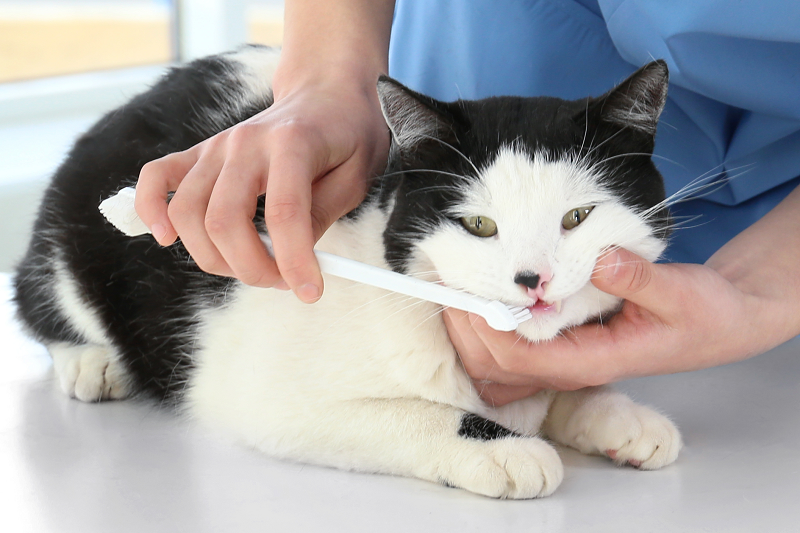
Before you start, make sure you’ve got all the supplies you need to give your cat’s teeth a thorough cleaning. Choosing the right toothpaste is crucial for maintaining your cat’s dental health. Look for toothpaste specifically formulated for cats, as human toothpaste can be harmful to them.
Additionally, understanding your cat’s dental anatomy is essential. Cats have 30 teeth that are designed for tearing and chewing their food. They also have small mouths, so it’s important to use a toothbrush with soft bristles that can reach all the nooks and crannies.
Now that you have gathered the necessary supplies and gained some knowledge about your cat’s teeth, let’s move on to the next step: introducing the toothbrush gradually.
Introduce the Toothbrush Gradually
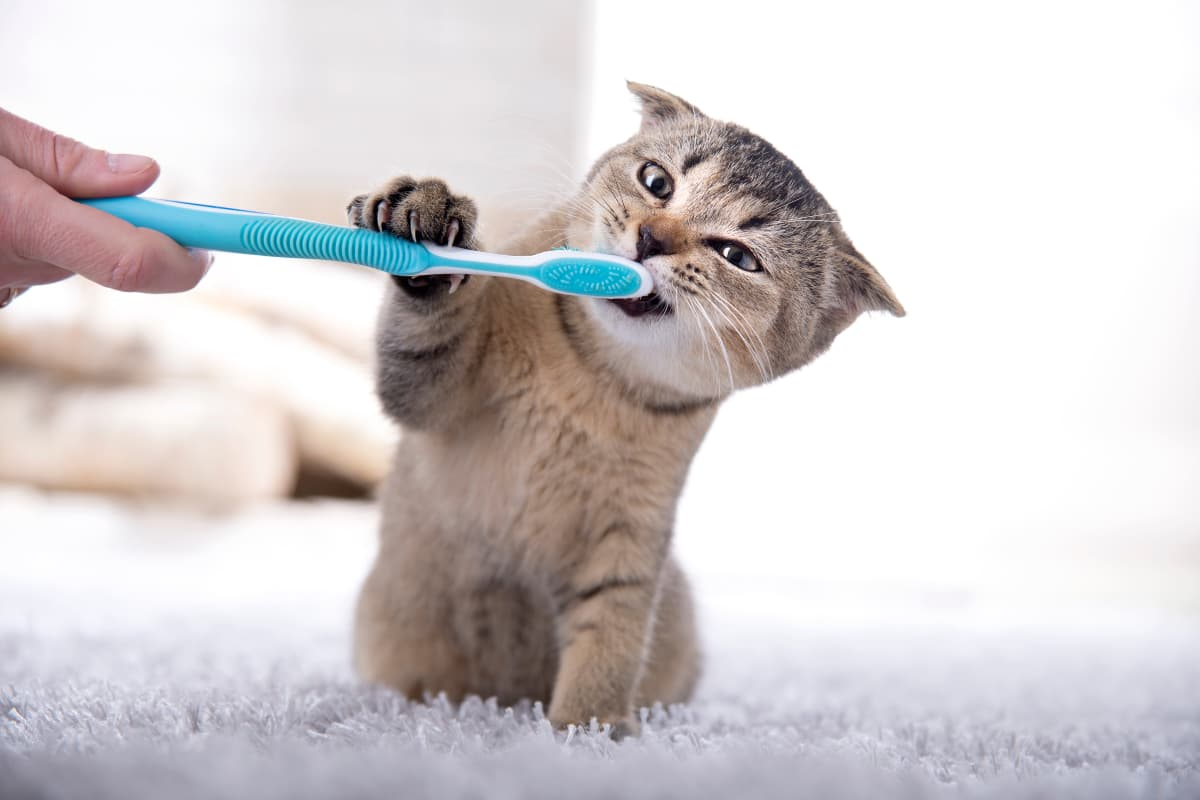
Gradually introducing the toothbrush to your feline friend is like slowly introducing a new toy that they can’t resist playing with. Start by letting your cat sniff and inspect the toothbrush, allowing them to get familiar with its scent and texture.
Then, gently touch their teeth and gums with the brush, using small circular motions. Remember to always go at your cat’s pace and stop if they become uncomfortable or stressed.
Positive reinforcement is key during this process. Reward your cat with praise, treats, or a favorite toy after each successful brushing session. This will associate the toothbrushing experience with something positive in their mind.
Once your cat becomes comfortable with the toothbrush, gradually increase the duration of each brushing session. Eventually, you’ll be able to establish a routine where brushing their teeth becomes a regular part of their daily care without causing any stress or discomfort for your furry friend.
Establish a Routine
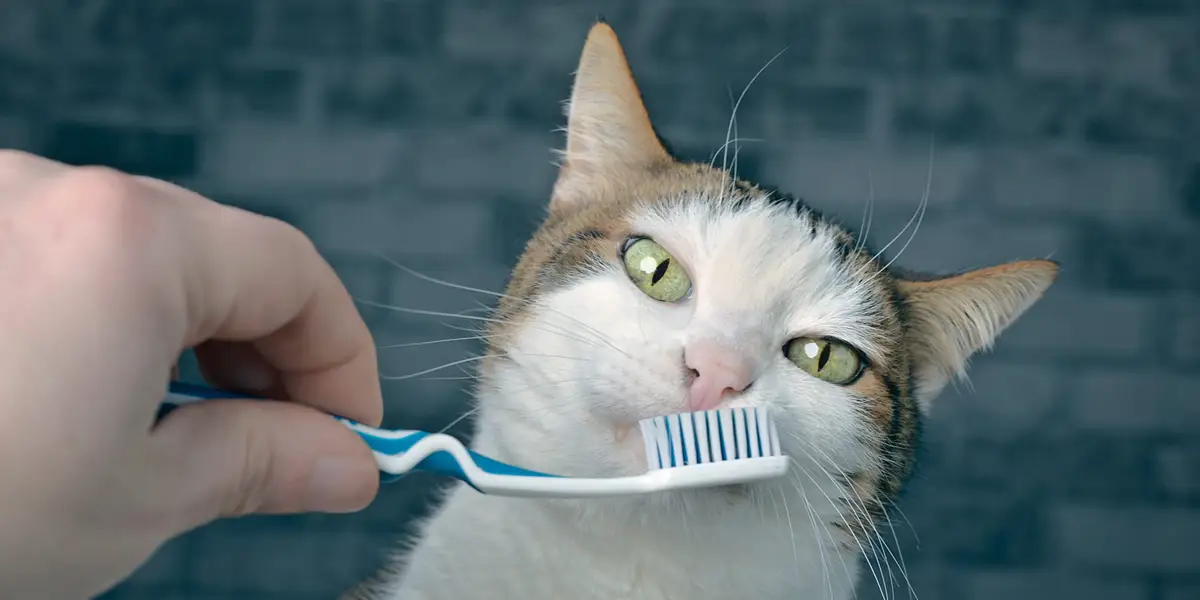
Start by incorporating toothbrushing into your daily routine, making it a consistent and enjoyable activity for both you and your furry companion. Building trust is crucial, so take it slow and be patient.
Begin by gently touching your cat’s mouth and teeth with your finger to get them used to the sensation. Gradually introduce the toothbrush, allowing them to sniff and lick it before actually brushing their teeth. Overcoming resistance may take time, but stay calm and reassuring throughout the process.
Once they are comfortable with the toothbrush, establish a regular brushing schedule that works for both of you. This will help them become more familiar with the routine and make toothbrushing less stressful. By creating a positive experience, your cat will begin to trust you more during this important dental care task.
Transitioning into proper brushing techniques is essential for maintaining good oral hygiene for your feline friend without causing any discomfort or harm.
Practice Proper Brushing Techniques
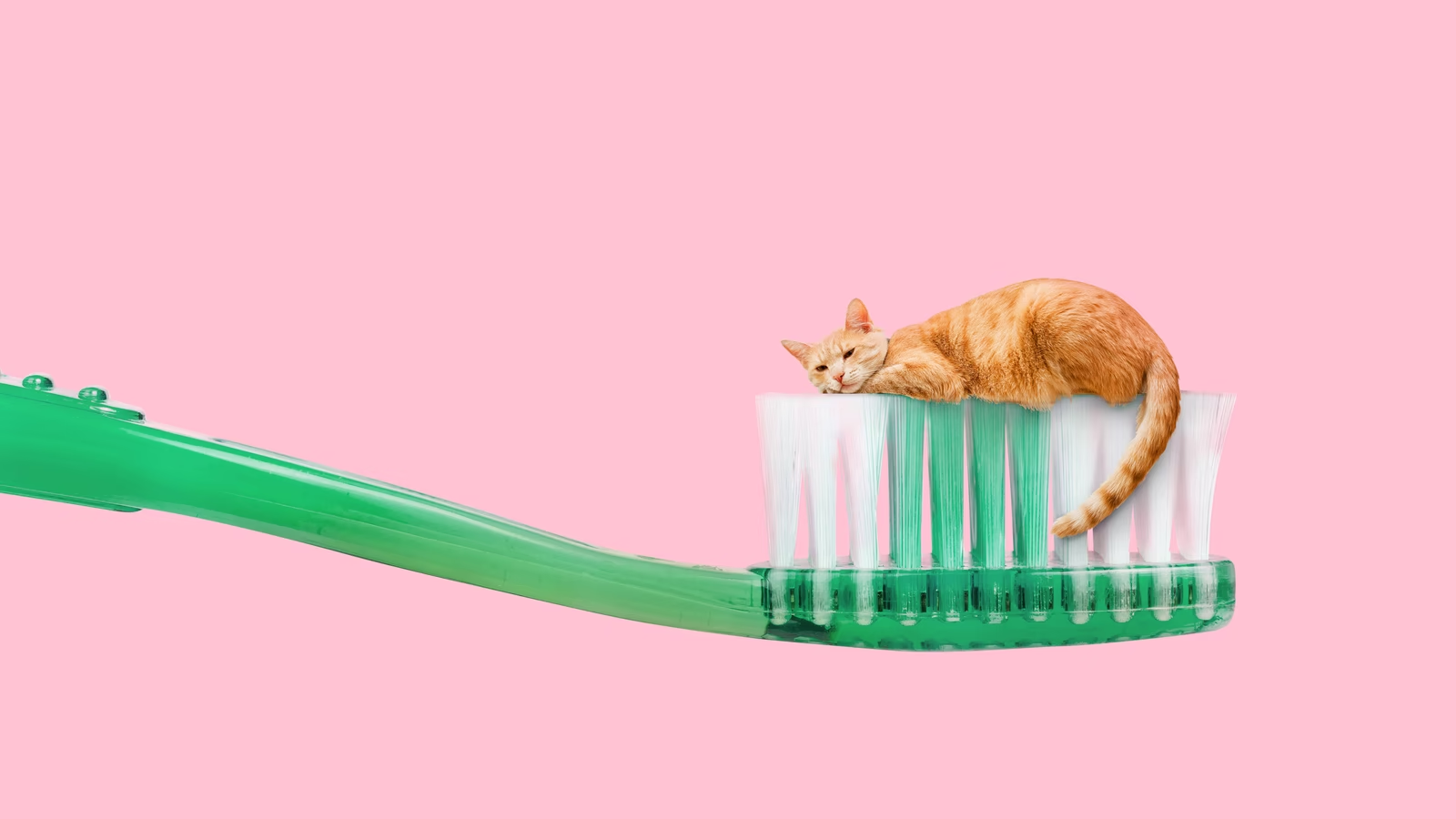
Mastering the art of feline dental care is like uncovering a secret treasure map to a dazzling smile. To practice effective brushing techniques, start by holding your cat gently but firmly. Position yourself comfortably and choose a toothbrush specifically designed for cats.
Begin with small circular motions, focusing on the outer surfaces of the teeth. Gradually work your way to the inside surfaces and along the gum line. Remember to brush in short sessions, aiming for 30 seconds to a minute each time. Use a gentle touch and be patient as you navigate around your cat’s mouth. And don’t forget to reward your furry friend with praise or treats after each successful brushing session!
Now, let’s move on to the next section about taking breaks if needed…
Take Breaks if Needed
Sometimes, it’s important to listen to your instincts and take a break if you feel overwhelmed during the process of caring for your feline companion’s dental health.
Cats can be resistant to having their teeth brushed, and it’s crucial to handle this resistance in a calm and patient manner. If you find that both you and your cat are becoming stressed or frustrated, it’s okay to step back and give yourselves some time to relax.
Taking breaks allows both of you to regroup and approach the task with a fresh mindset. Remember, forcing the brushing can lead to negative associations, making future attempts even more difficult. So take a breather when needed, ensuring a more positive experience for both you and your furry friend.
In the next section on ‘rewarding your cat for cooperation,’ we’ll explore ways to make toothbrushing an enjoyable activity for your cat.
Reward Your Cat for Cooperation
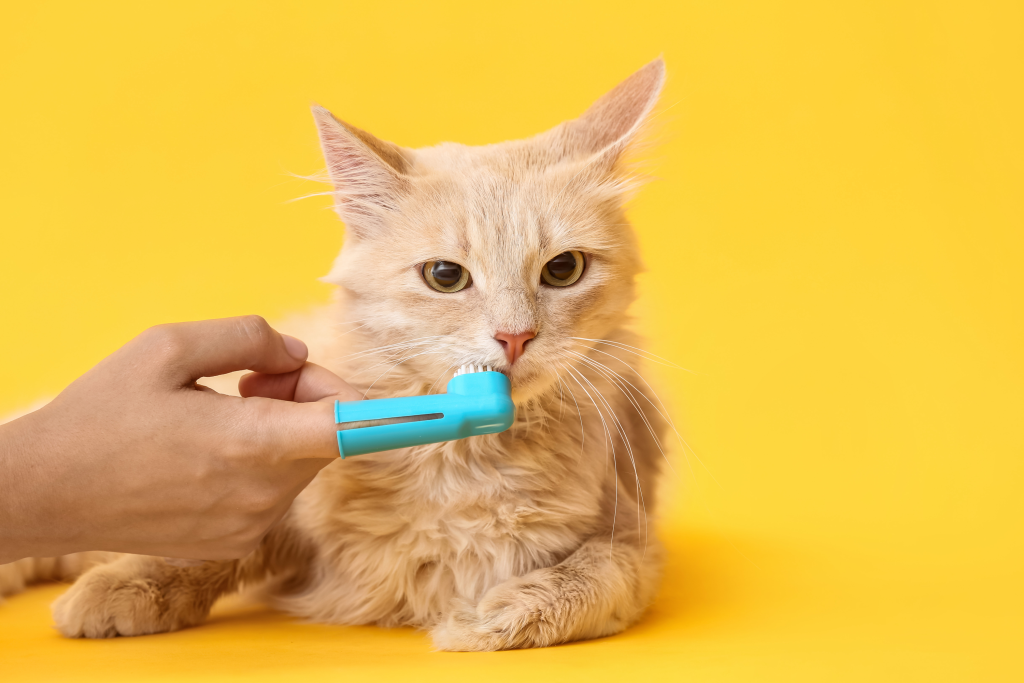
Encouraging your feline companion to cooperate can be achieved by rewarding them for their efforts in maintaining good dental health. Positive reinforcement is key when it comes to brushing your cat’s teeth. Here are some tips on how to reward your cat for their cooperation:
Use treats: Give your cat a treat after each successful tooth-brushing session.Praise and petting: Shower your furry friend with praise and affection to show them that they’re doing a great job.Playtime: Engage in playtime with your cat as a reward for their cooperation during the teeth brushing process.Favorite toys: Offer your cat their favorite toy as a special reward.
By using these techniques, you can make the teeth-brushing experience more enjoyable for your cat.
Transitioning into the subsequent section about regularly scheduled professional dental cleanings, remember that while at-home care is important, it should be supplemented with regular check-ups and cleanings from a veterinarian.
Regularly Schedule Professional Dental Cleanings
To ensure the best dental health for your cat, it’s important to consult with your veterinarian. They can provide guidance on when and how often professional dental cleanings should be scheduled based on your cat’s specific needs.
By maintaining regular dental cleanings, you can help prevent tartar buildup, gum disease, and other oral health issues in your furry friend.
Consult with Your Veterinarian
Make sure to schedule a visit with your vet to discuss the best way to care for your cat’s oral health. Your veterinarian is an expert who can provide valuable recommendations based on your cat’s specific needs. Here are three reasons why consulting with your vet is crucial for maintaining your cat’s dental health:
Expert Advice: Your vet has extensive knowledge and experience in feline dentistry, making them the best person to guide you on how to brush your cat’s teeth effectively.Dental Health Importance: Your vet will explain the importance of dental health for cats, emphasizing how it can prevent painful conditions like gum disease, tooth decay, and even organ damage.Customized Care Plan: By consulting with your vet, you can develop a personalized dental care plan that suits your cat’s age, breed, and overall health condition.
By understanding the significance of veterinary recommendations and dental health importance, you’ll be better equipped to maintain your cat’s oral hygiene at home smoothly and efficiently without compromising their well-being.
Maintain Your Cat’s Dental Health
Now that you’ve consulted with your veterinarian about brushing cat teeth, it’s time to learn how to maintain their dental health.
Preventing dental issues in cats is crucial for their overall well-being. Just like humans, cats can develop plaque and tartar buildup. This can lead to painful dental problems such as gum disease and tooth decay. By regularly brushing your cat’s teeth, you can help prevent these issues.
To start, introduce your cat gradually to the idea of tooth brushing. Use a pet toothbrush or finger brush and specially formulated cat toothpaste. Make sure to brush all sides of their teeth and focus on the gum line where bacteria tend to accumulate.
Additionally, feeding your cat a balanced diet and providing them with dental treats or toys can also help promote good oral hygiene.
Remember, maintaining good dental health is essential for your feline friend’s overall health and quality of life. So make it a routine part of their care and enjoy many years of happy purrs!
Frequently Asked Questions
How often should I brush my cat’s teeth?
To make teeth brushing a positive experience for your cat, start by introducing the process gradually and using rewards. Brushing regularly is important for your cat’s dental health, which affects their overall well-being.
Can I use a regular toothbrush for my cat?
Can you use a regular toothbrush for your cat? Yes, you can! When brushing your cat’s teeth, using a soft-bristled toothbrush designed for pets and utilizing effective brushing techniques will ensure proper dental care.
What if my cat resists brushing their teeth?
To deal with a stubborn cat during teeth brushing, try these tips for overcoming resistance: start by getting your cat comfortable with the toothbrush, use tasty toothpaste, be patient and gentle, and reward your cat afterward.
Are there any alternatives to brushing my cat’s teeth?
There are alternative dental care options for cats if they resist brushing. Professional teeth cleaning may be necessary, but you can also try dental treats, water additives, and oral gels or sprays recommended by your vet.
How long does it take for my cat to get used to teeth brushing?
To introduce a toothbrush to your cat, start by letting them sniff and play with it. Gradually, begin brushing for short periods every day. Signs that your cat is comfortable include relaxed body language and allowing you to brush their teeth without resistance.
Conclusion
Now that you’ve learned the essential steps to brushing cat teeth, it’s time to put them into practice. Remember, patience and consistency are key when it comes to maintaining your cat’s dental hygiene.
As you gather the necessary supplies and gradually introduce the toothbrush, imagine the satisfaction of seeing your feline friend with a bright smile and healthy teeth. Establishing a routine and practicing proper brushing techniques will ensure optimal results. And don’t forget to reward your cat for their cooperation along the way.
Finally, regularly scheduling professional dental cleanings will provide additional support for your pet’s oral health. So go ahead, and embark on this journey towards better dental care for your beloved kitty!
Read more:
Cat Grooming Guide: Benefits And How To Do It
How To Keep Your Feline Friend At A Healthy Cat Weight





